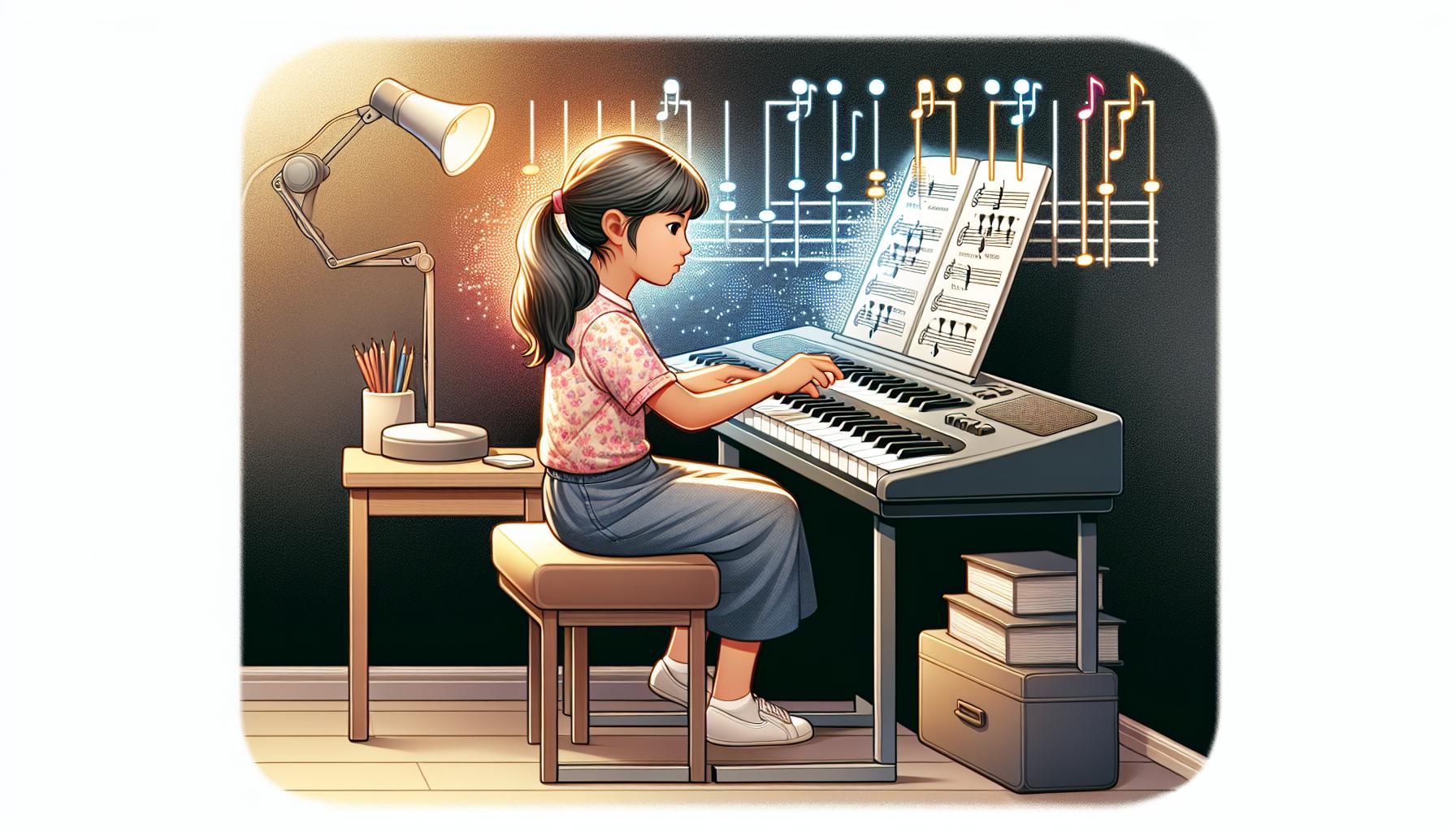Starting on the musical journey can be both exciting and a bit daunting. But what if there was something to make it a tad easier? Enter the world of keyboards with light-up keys, a beginner's best friend. These nifty instruments are not just about the cool factor; they're about paving the way for easy learning and fun practice sessions.
Imagine hitting the keys and having them light up to guide your fingers to the next note. It's like having a music teacher available 24/7, right in your living room! For those just dipping their toes into the vast ocean of music, a keyboard with light-up keys could be the perfect starting point. Let's dive into why these illuminated wonders are making waves among beginners.
Benefits of Keyboard with Light-Up Keys
Keyboards with light-up keys have revolutionized how beginners approach learning the piano. They offer a unique set of advantages that can make the journey into music both enjoyable and effective. This section delves into the key benefits that make these instruments particularly suited for new musicians.
Firstly, light-up keys provide visual guidance. For someone just starting, remembering which notes correlate to which keys can be daunting. Here, light-up keys shine, quite literally. As the keys light up to indicate the next note in a song, beginners can follow along without constantly referring to sheet music. This direct visual guidance helps embed the location of notes in muscle memory quicker than traditional methods.
Moreover, these innovative keyboards make practice sessions more interactive and engaging. Let's face it, repetitive drills can get tedious. However, when the keyboard lights up in response to correct or incorrect presses, it adds a playful element to learning. Some models even come with games and challenges, transforming practice time from a chore into a fun, highly anticipated activity.
Accessibility is another strong point. Keyboards with light-up keys often come equipped with built-in songs and tutorials, making them self-contained learning tools. Beginners don't need to buy additional books or subscribe to online courses immediately. They can start their musical journey right out of the box, making these keyboards not only practical but also cost-effective for newcomers.
The immediate feedback provided by light-up keyboards is invaluable for learning. When players hit the wrong note, they know it instantly because the corresponding key won't light up as expected. This instant correction helps learners adjust their play in real time, encouraging a more dynamic learning process. Over time, this feedback loop significantly improves accuracy and timing.
Furthermore, light-up keyboards often feature different learning modes. These modes might include one that lights up the next series of notes to play, another that only proceeds when the correct keys are pressed, and so on. This adaptability allows learners to tailor their experience to their specific needs, making these keyboards versatile tools in the arsenal of a beginner.
Here are some key statistics highlighting the impact of light-up keyboards on beginners:
| Aspect | Statistic |
|---|---|
| Memory Retention | 70% of learners report improved note recognition |
| Practice Enjoyment | 85% find practice more enjoyable with interactive features |
| Learning Pace | 65% believe they learn faster with visual guidance |
Features to Look for in a Beginner Keyboard

When diving into the world of music, choosing the right keyboard can make all the difference for a beginner. With the popularity of keyboards with light-up keys on the rise, it's essential to know what features stand out, making learning both enjoyable and effective.
Light-Up Keys are a must-have for any beginner keyboard. They guide learners through songs note by note, turning practice sessions into an interactive experience. This visual aid not only aids in memory retention but also keeps motivation high.
Key Touch Sensitivity plays a crucial role in developing a beginner's dynamics in music. Keyboards equipped with this feature respond to the pressure applied, producing louder or softer sounds accordingly. This enables new musicians to experiment with emotion and expression through their playing.
Built-In Learning Tools are invaluable for those starting their musical journey. Look for keyboards that offer a variety of tutorials, built-in songs, and challenges. These tools provide beginners with a structured learning path, enabling them to progress at their own pace.
Recording and Playback Features allow beginners to listen back to their performances. This not only aids in self-assessment but also tracks progress over time. Such features encourage learners to keep practicing, as they can literally hear their improvement with each session.
Sound Quality and Variety can greatly impact a beginner's enthusiasm and engagement. Keyboards that offer a range of sounds and rhythms inspire creativity and keep practice interesting. From grand pianos to strings and percussion, the ability to experiment with different sounds can be incredibly motivating.
Connectivity Options such as USB or MIDI ports make it easier for beginners to connect their keyboards to computers or other devices. This expands the learning resources available to them, including online tutorials, software, and apps designed to enhance their learning experience.
Consider the Size and Number of Keys. For beginners, a keyboard with 61 keys is often sufficient, providing enough range for learning while being more manageable and often more affordable than larger options. However, aspiring players with a keen interest might prefer the full range of 88 keys to mimic an acoustic piano more closely.
Lastly, Portability can be a factor worth considering, especially for those with limited space or who wish to practice in different locations. Lightweight keyboards with options for battery operation offer the flexibility to play almost anywhere, making music a part of daily life.
Top Picks for Beginner Keyboards with Light-Up Keys

Choosing the right beginner keyboard with light-up keys is crucial for a smooth and enjoyable learning journey in music. To help with this decision, we've curated a list of top picks that stand out for their features, quality, and user reviews.
Casio LK-S250
The Casio LK-S250 is a crowd favorite, striking the perfect balance between functionality and affordability. Its 61 light-up keys are a visually engaging feature that beginners appreciate for the immediate feedback it provides during practice sessions. Alongside this, its touch-sensitive keys help in developing a sense of dynamics from the start.
- Touch-Sensitivity: Yes
- Number of Keys: 61
- Connectivity: USB to host
Additionally, the LK-S250 boasts an impressive array of 400 tones and 77 rhythms, providing ample room for creative exploration. It's also light and portable, making it an excellent choice for those on the move.
Yamaha EZ-220
Another top contender is the Yamaha EZ-220, renowned for its superior sound quality and comprehensive learning features. It offers 61 lighted keys and a built-in wireless connectivity option to Yamaha’s Page Turner application for iPad, further enriching the learning experience.
- Touch-Sensitivity: Yes
- Number of Keys: 61
- Connectivity: USB to host, Wireless
With 392 instrument voices and 100 styles, the EZ-220 ensures that students have a wide range of sounds and backing tracks at their disposal. It's particularly admired for its Yamaha Education Suite (Y.E.S.), which allows learners to practice using the preset songs at their own pace.
Roland GO:KEYS GO-61KL
The Roland GO:KEYS GO-61KL is designed for those who value innovation and versatility. What sets this model apart is its Bluetooth connectivity, allowing students to pair it with their smartphone or tablet and access various online music creation platforms easily.
- Touch-Sensitivity: Yes
- Number of Keys: 61
- Connectivity: Bluetooth MIDI/USB MIDI
Besides its intuitive interface, it offers over 500 ready-to-play sounds, spanning from pianos and strings to synths and drums, encouraging musical experimentation and production. Though slightly pricier, its build quality and technological edge make it a worthwhile investment.
Tips for Learning on a Keyboard with Light-Up Keys

Embarking on a musical journey with a keyboard featuring light-up keys can be an exciting adventure for beginners. These instruments are tailored to guide learners through songs and exercises with visual aids. To make the most of this experience, here are some effective tips.
Start With Simple Songs
Beginning with simple melodies not only boosts confidence but also helps in understanding the basic functionalities of the keyboard. It’s easy to get overwhelmed by the array of features, but mastering simple tunes allows for a progressive buildup of skills.
Consistent Practice Routine
Consistency is key in mastering any instrument. Setting aside a specific time each day for practice can significantly accelerate learning. Even short, focused sessions can lead to substantial progress over time.
Use the Light-Up Features Creatively
While the primary use of the light-up keys is to follow along with songs, they can also be employed creatively. For instance, experimenting with light patterns can aid in learning scales and chords. Seeing the keys light up in sequence can embed the shapes of chords and scales in a beginner’s memory.
Take Advantage of Built-In Lessons
Many keyboards with light-up keys come equipped with pre-programmed lessons. Thoroughly exploring these lessons can provide a structured learning path and introduce essential music theories in an interactive manner.
Engage With Online Resources and Apps
There’s a wealth of online resources and apps designed to complement keyboards with light-up keys. These platforms often offer additional songs, exercises, and even games that make learning engaging and fun. They’re a fantastic way to expand beyond what's available on the keyboard itself.
Track Your Progress
Monitoring improvement is crucial. This can be as simple as recording practices with a smartphone to listen back and identify areas for improvement. Many keyboards also offer progression tracking within their learning software, allowing learners to see tangible evidence of their advancement.
Be Patient and Enjoy the Process
Learning an instrument should be a source of joy, not frustration. It's important to celebrate small victories and understand that everyone learns at their own pace. Patience and persistence are essential traits for any budding musician.
Conclusion
Choosing a good beginner keyboard with light-up keys is just the first step in a rewarding musical journey. By following the tips outlined, learners can make the most out of their practice sessions and truly enjoy the process of learning music. It's about blending creativity with discipline, exploring the vast world of music with a sense of adventure, and allowing oneself the grace to grow at their own pace. Remember, every musician's path is unique, and with patience and persistence, those first simple songs will soon turn into complex compositions that reflect the player's hard work and passion. So, keep those keys lighting up, and let the music play!
Harlan Kilstein began playing piano during covid with no piano background at all. He taught himself how to play learning what to do and what not to do.
Today he's an advanced intermediate player and can help you grow in your skills because he learned all this on his own.








